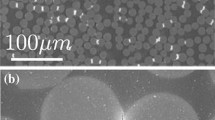Abstract
The adhesion of UKN-01 carbon fibers to a PA-12 polymeric matrix is investigated by the method of testing single-fiber model composites. The distribution of critical fiber length is constructed from measurements of fragment lengths formed in the final stage of testing. Variation in the distribution of critical length is established as a result of surface treatment of the reinforcing fiber. A bimodal distribution corresponds to the initial carbon fiber, and a monomodal distribution to the treated fiber. This is explained by replacement of a physicomechanical type of interaction of the phase interface by a physicochemical interaction owing to electrochemical treatment of the fiber surface. Analysis of the results indicated that each type of interphase interaction has its own characteristic critical length. The selection of critical length has been confirmed for calculation of the interphase shear strength by the Kelly-Tyson formula.
Similar content being viewed by others
References
Yu. A. Gorbatkina, Adhesion Strength in Polymer-Fiber Systems [in Russian], Khimiya, Moscow (1987).
Interlayer Effects in Composite Materials [Russian translation], N. Pagano (ed.), Mir, Moscow (1993).
S. F. Zhandarov, E. V. Pisanova, and V. A. Dovgyalo, “Tensile fragmentation of a single fiber in a matrix as a method of determining adhesion,” Mekh. Kompoz. Mater., No. 3 384–403 (1992).
A. Kelly and W. R. V. Tyson, “Tensile properties of fiber-reinforced metals: copper/tungsten and copper/molybdenum,” Mech. Phys. Solids, No. 3, 270–274 (1965).
Yu. G. Korabel'nikov, I. A. Rashkovan, V. P. Tamuzh, A. A. Karklin'sh, Yu. A. Gorbatkina, and T. Yu. Zakharova, USSR Author's Certificate No. 1704015, “Method of determining the scale dependence of the strength of a fiber on its length,” effective September 8, 1989, Otkr. Izobr., No. 1, 168–169 (1992).
V. P. Tamuzh, Yu. G. Korabel'nikov, I. A. Rashkovan, A. A. Karklin'sh, Yu. A. Gorbatkina, and T. Yu. Zakharova, “Determination of the scale dependence of the strength of fibrous fillers and assessment of their adhesion to the matrix from test results of elementary fibers in a polymer block,” Mekh. Kompoz. Mater., No. 4, 641–647 (1991).
Yu. A. Gorbatkina, Yu. G. Korabel'nikov, V. P. Tamuzh, T. Yu. Zakharova, and I. A. Rashkovan, “Some characteristic features of use of the acoustic emission method in studying fragments of single fibers in a polymeric matrix,” Mekh. Kompoz. Mater., No. 6, 734–740 (1993).
H. D. Wagner and A. Eitan, “Interpretation of the fragmentation phenomenon in single-filament composite experiments,” Appl. Phys. Let.,56, No. 20, 1965–1967 (1990).
M. C. Watterbury and L. T. Drzal, “On the determination of fiber strength by in-situ fiber strength testing,” J. Composite Techn. Res.,13, No. 1, 22–28 (1991).
I. L. Kalnin, “The surface of carbon fibers, its modification, and effect on the failure of high-modulus carbon plastics,” Mekh. Kompoz. Mater., No. 3, 397–406 (1979).
Additional information
“Uvikom,” Moscow Oblast, Russia. Translated from Mekhanika Kompozitnykh Materialov, Vol. 33, No. 1, 98–103, January–February, 1997.
Rights and permissions
About this article
Cite this article
Rashkovan, I.A., Korabel'nikov, Y.G. Critical length and distribution of fibrous fillers and composites. Mech Compos Mater 33, 70–73 (1997). https://doi.org/10.1007/BF02274251
Received:
Issue Date:
DOI: https://doi.org/10.1007/BF02274251




